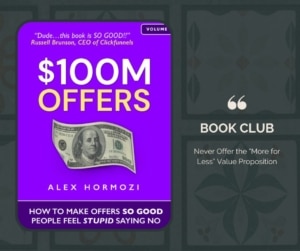Book Club #30: $100M Offers: How To Make Offers So Good People Feel Stupid Saying No, by Alex Hormozi
 Alex Hormozi begins his short book $100M Offers with a story from Jeff Bezos. In it, Bezos discusses the similarities between baseball and business, particularly the idea that you’re not going to hit a home run (or even a base hit) every time you step up to bat. But there’s a key difference. On your best at-bat in baseball you can only bring in 4 runs. But on a “grand slam” in business, you can bring in the equivalent of 1000 runs. “Big winners pay for so many experiments,” says Bezos.
Alex Hormozi begins his short book $100M Offers with a story from Jeff Bezos. In it, Bezos discusses the similarities between baseball and business, particularly the idea that you’re not going to hit a home run (or even a base hit) every time you step up to bat. But there’s a key difference. On your best at-bat in baseball you can only bring in 4 runs. But on a “grand slam” in business, you can bring in the equivalent of 1000 runs. “Big winners pay for so many experiments,” says Bezos.
Hormozi’s book is entirely oriented towards getting you that 1,000 runs for your business using what he calls “Grand Slam Offers,” offers so good that, “people feel stupid saying no” to them.
While a great deal of the book is dedicated to surgical explanations of how to craft a fantastic offer (and that’s very useful) there are some key ideas that Hormozi puts forward that give proper context for how these offers should be positioned.
Never Offer the “More for Less” Value Proposition
Hormozi notes that many players enter the marketplace and charge approximately what the competition charges, but with an extra or two in order to create the “more for less” value proposition. But this is a fool’s errand.
Not only does this indicate the simple path any future competitor of yours can take, but it’s ultimately a race to the bottom. Go the other way, Hormozi notes: charge more for more. By serving niches and serving them well, you can begin to dictate your prices instead of the market dictating your price to you.
9% Growth Should Be Standard
While most people know that the stock market grows roughly 9-10% a year, they don’t normally apply that metric to their businesses. Hormozi does. If you’re not keeping up with the growth in the market, you’re falling behind. While not everyone may like this metric, it’s certainly a hard one to disagree with.
Use Objections to Create Features
Hormozi now is in many different industries, but he started out helping gyms bring in more revenue. Hence many of his examples or templates in the book use fitness/nutrition starting points.
One of the examples he gives is the idea of getting people to eat healthier instead of going for liposuction. He then offers a whole list of objections that people might give to eating healthier. Hormozi then reframes those objections as reasons to buy.
For example, if someone says that eating healthy is “too expensive” a headline for a blog or a heading on a sales page might read:
“How Eating Healthy Can Save You Money”
Another objection might be that it takes too much time to cook healthier food. Again, the reframe looks like:
“5 Healthy Meals You Can Make in Under 30 Minutes”
Hormozi notes that there are many different reasons that customers buy, but if even one objection they have is unaddressed, that can lead them to walk away. By anticipating every single objection they might have and reframing them as features, you build momentum towards a transaction. Since you’re not stopping/starting with objections and answers to objections, customers are free to proceed on the customer journey unimpeded towards a sale.
Hormozi’s entire book is oriented towards helping you:
- Get more customers
- Increase their average purchasing value
- Increase the frequency of their purchases
If you’re looking for different ways to reframe and/or upgrade the offers you currently have, this is an excellent resource.


